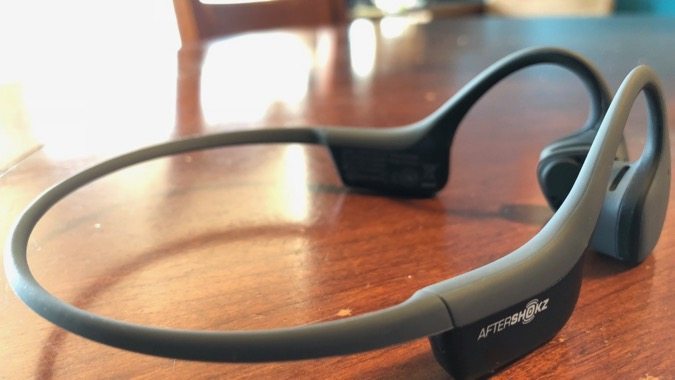
With so many types of headphones on the market, it can be hard to choose the “right” headphones. Bone conduction headphones are not the best choice for all situations from a sound quality perspective, but they do allow you do take your music with you without having to sacrifice your situational awareness. If you need to hear things around you, bone conduction headphones are the way to go.
What Are Trekz Air Bone Conduction Headphones?
Trekz Air headphones are the latest line of bone conduction headphones from AfterShokz… 20% lighter their previous line of headphones thanks to the extensive use of titanium in the headphone frames. At first, a 20% reduction in weight may not seem like much, but I stopped by the AfterShokz booth at CES this year and got to try on both the Trekz Air and their previous generation of headphones and the difference was significant. The “Air” moniker makes sense with these headphones and they seem to disappear into thin air when you put them on. The previous generation of headphones from AfterShokz were already light, but the use of titanium allowed them to make the frames much thinner without sacrificing strength. So in additional to being lighter, the headphone frames are extremely thin which translates into comfort for the user. Here are just a few of the features of the Trekz Air headphones:
- PremiumPitch+™ dynamic stereo sound and increased bass
- Open Ear Design
- Dual Noise Canceling Mics
- Complete Titanium Frame
- Sweat Resistant IP55 certified
- LeakSlayer™ reduced sound leakage
- New Antenna with improved Bluetooth connection (Bluetooth V4.2)
- 6 Hours of Music + Call Time
Why Use Bone Conduction Headphones?
Bone conduction turns audio into vibrations that go straight into your inner ear (via your jaw bone) from the tabs that sit just above the outside of your ear in the headphones. Normal audio that enters your ear gets converted from sound waves into vibrations by your eardrum. Vibrations from the eardrum are then sent to the cochlea (also known as the inner ear) and that is connected to the auditory nerve which sends the sound signals to your brain. Bone conduction bypasses your eardrum and transmits the vibrations straight to your inner ear by sending vibrations into your jaw bone. But why would you want to do that? There are two main reasons: safety and comfort.
There are a lot of activities you might be involved with that require you to be aware of your surroundings but are much more enjoyable when you can listen to music while doing these activities. Bone conduction audio allows you to hear things going on around you and your music all at the same time. Sound from the environment around you still enters your ear the normal way and your music is sent via vibrations directly into your inner ear… essentially giving you an extra channel of audio. So if you are out for a run on sidewalks or neighborhood streets, you can enjoy your music but still hear traffic and things going on around you so you stay out of harm’s way. Bone conduction is also more comfortable than traditional headphones for extended use because you don’t have much surface area touching your skin, just the small vibration pads, and they are not pressing up against your ears like traditional headphones.
Verdict
The Trekz Air headphones aren’t going to win any sound quality awards, but to be fair that isn’t what they were made to do. Surprisingly, there is some bass to the audio and if you pay attention to the vibration pads you know why. These things can really produce vibrations. In fact, when my wife tried out the Trekz Air headphones, her nose tickled. She broke her nose rather severely as a child, and ever since then the cartilage in her nose has been degrading, so much so that at some point she will need reconstructive surgery. While this is not an issue very many people will have, it is something to keep in mind if you have had a similar injury. I’ve avoided having my nose broken (so far), so for me, after wearing the headphones for a minute or two, I don’t even notice the vibrations. The high notes are clear and pronounced in the audio and the bass is adequate for most types of music.
From a comfort perspective, the Trekz Air headphones practically disappear behind your ears when you wear them. The titanium frame makes them so lightweight that they don’t put any appreciable pressure on the tops of your ears. The frames are also thin enough so you can wear a hat and sunglasses and there is no interference whatsoever. One tip though: when you wear the Trekz Airs make sure they aren’t riding too far down on the base of your neck. If you rotate them down too far and they touch at the base of your neck, the headphones will interfere with the movement of your head or jostle around when running. But if they are allowed to “float” above the base of your neck, you have total freedom of movement and the headphones don’t move. Even wearing a hat backwards doesn’t interfere with wearing the Trekz Airs.

I am loving the Trekz Air headphones for certain situations. They are great to use while outside running and I am also wearing them quite a bit while doing chores around the house. I own a pair of Apple’s AirPods and I love them, but if I am listening to music or a podcast while doing the dishes, I will inevitably have someone come up to me while I am in dishwater up to elbows and ask me a question. That usually leads to me having to stop what I’m doing, shake the water off of my hands and pull one of the AirPods out of my ear so I can hear their question. If I wear the Trekz Airs then I can still hear when spoken to. So unless I have a specific need to drown out what is going on around me, I am now wearing the Trekz Airs around the house while doing chores. Trekz Airs would also be ideal to use while outside riding a bike. I already own a bicycle helmet that has bone conduction audio built-in, but if you don’t, the Trekz Airs are thin enough to be worn right along side a normal bike helmet (if you wear one). Bone conduction headphones are also great if you are outside doing work in the yard with your family and you still need to be able to listen to people around you and talk but also want to take your music with you.
If you listen to a lot of music and podcasts like I do, then you might want to check the Trekz Air headphones out. When I received these headphone to review I thought I would only use them while running outdoors but I found them to be a better audio solution for other situations as well. Trekz Air headphones are available for purchase directly from the AfterShokz website or from Amazon.com.
Disclaimer: AfterShokz provided me a pair of Trekz Air headphones to put through the rigor of my workouts and sweat all over for the purposes of this review and for some reason they didn’t want them back.





I’ve been using the trekz Titanium (previous model to the air) for over two years now at work. I’m a valet in Las Vegas… The trekz pairs with our Bluetooth 2way radios. I can hear all traffic around me and still talk to guests and be in communication with my co workers. Many of them use a standard in ear Bluetooth which I see them pull out when talking to someone in front of them… No need to that we the trekz. Solid product that takes a Vegas valet beating. I had to return the air as our radios have a very old version of Bluetooth and would not pair. But I would absolutely recommend them to anyone who needs situational awareness… Like joggers, or bikers, or valet drivers.
Thanks Phil! This bone conduction technology has a lot of potential applications.